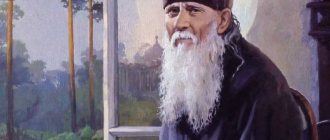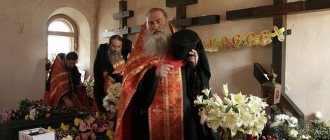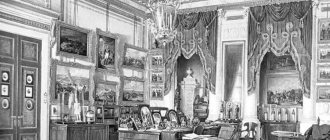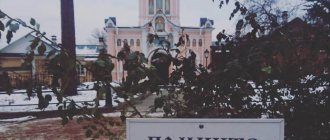The buildings of the Holy Vvedensky Stavropegic Monastery, better known as Optina Monastery, were transferred to the jurisdiction of the Russian Orthodox Church in November 1987. Soon, pilgrims from all over Russia flocked to the monastery returned to the church in the Kaluga region: the church-going Orthodox were attracted by the glory of the Optina elder Ambrose Optinsky (1812-1891), who was canonized the following year, the intelligentsia - the name of Dostoevsky, who sought consolation here after the death of his three-year-old son Alyosha and brought the venerable Ambrose in “The Brothers Karamazov” under the name of Zosima, informal youth were captivated by Optina’s casual mention in one of the first big interviews of the then iconic Boris Grebenshchikov.
In July 1988, when the brethren of the monastery, in addition to the abbot, numbered only two hieromonks, two hierodeacons and four novices, the first liturgy was celebrated here, which was remembered by eyewitnesses as “such a wave of grace that strangers, like relatives, rushed to hug each other.” In those years, in the monastery, which had not yet been rebuilt after decades of neglect (under Soviet rule, there was a vocational school where machine operators were trained), an atmosphere of exaltation reigned: pilgrims call it “a land of wonders,” and, returning home, they willingly share stories about the special grace of this place and signs and wonders surrounding him.
It is becoming fashionable to go here - despite the spartan conditions in the monastery building reserved for guests, the almost army discipline and the frightening severity of the Optina confessors. Under the guidance of monks, pilgrims perform “obediences”: they work to restore the monastery walls, make furniture, carry water, prepare firewood, and work in the kitchen. “At that time, there were teenagers living at the monastery - one of those who in our time are called “hippies”, but in the old days they were called “tramps.” Orphans, half-orphans, from the age of 8-12 they wandered from den to den, where the child was given drugs and a syringe instead of milk. And they clung to the monastery not yet out of an excess of faith, but rather out of that instinct by which freezing sparrows huddle in the cold to warm housing. In Optina they were called that - our “sparrows”,” the writer Nina Pavlova described the community of young volunteer “workers” that had formed around the monastery.
Residents of the surrounding villages, however, treated the clergy who returned to these places differently. One day in the early 1990s, a noticeable black inscription “MONKS ARE DOGS ****** [harloty]” appeared on the wall of the monastery from afar, but it is unknown who exactly left it.
The idyll in Optina was unexpectedly interrupted in April 1993, on Easter, when a triple murder was committed in the monastery.
Vasily, Trofim and Ferapont
A graduate of the journalism department of Moscow State University, Muscovite Igor Roslyakov came to Optina Pustyn in the year when the restoration of the monastery was just beginning. The clergy noted that the young novice was a diligent, silent and modest person: he performed any work flawlessly.
At the university, Roslyakov studied diligently. Senior lecturer at the Faculty of Journalism Tamara Chermenskaya spoke of him as a very talented young man. “Students in those years were interested in Zen Buddhism, and a stream of philosophical literature mixed with occultism came from the West. I tried to prevent this poison from touching Igor’s soul, fortunately, when he needed advice, it was easy to do so,” the church-going teacher shared her memories. Roslyakov became a frequent guest in her house, however, Chermenskaya claims, it was not she who converted the student to Orthodoxy - over time, Roslyakov allegedly himself was drawn to the faith.
The first change in her son was noticed by his mother. Suddenly, Igor, who had previously painstakingly collected his home library, took all Leo Tolstoy’s books out of the house: “Mom, he’s a heretic!” Tolstoy was replaced by the works of St. Ignatius Brianchaninov, the young man began going to church services, and then left for Optina Pustyn.
Only a few years after Roslyakov settled in the monastery, it turned out by chance that in the world Igor was the captain of the Moscow State University water polo team - one of the pilgrims found his photograph with a cup in the Izvestia newspaper. In Optina, the young novice kept himself apart and did not talk about his past life. According to the inhabitants of the monastery, he put a lot of effort into restoring the monastery and soon became a monk, and then a hieromonk, taking the name Vasily.
Signature
The complete opposite of Roslyakov was Leonid Tatarnikov, later named monk Trofim. The brethren and parishioners knew him well - the young man, who came to Optina in August 1990 from Biysk, stood out for his liveliness of character; he quickly scurried around the monastery and, without hesitation, took on any work. In the world, Tatarnikov managed to change several professions - after serving in the tank forces, he worked in the Sakhalin fishery, was engaged in artistic photography, was a photojournalist in a regional newspaper, a shoemaker, a shepherd and a fireman. He explained his departure to the monastery to his relatives as a sign: he saw a dazzling light emanating from one of the icons in the temple, and heard an unearthly voice.
Being an impatient man, Tatarnikov was in a hurry to become a monk. In Optina they recalled that once he came to ask that his tonsure be done as quickly as possible. “Or maybe you should be tonsured into the schema right away?” - asked the priest to whom he turned. “Father, I agree!” - Tatarnikov exclaimed then. For this - or some other offense - Tatarnikov was denied residence within the walls of the monastery for two months. The young man settled in a dugout nearby, but did not miss a single service. At the monastery, he managed the pilgrimage hotel, worked as a bell ringer, bookbinder, and repaired clocks.
Less than a year after his arrival, Tatarnikov achieved his goal and took monastic vows under the monastic name Trofim. “Trofim was the spiritual Ilya of Muromets, and he generously poured out his love on everyone in such a heroic way that everyone considered him their best friend. Me too. He was everyone’s brother, helper, relative,” Abbot Vladimir recalled about Tatarnikov.
Another future inhabitant of Optina, Siberian Vladimir Pushkarev, appeared at the monastery in June 1990, having walked 75 kilometers from Kaluga. Locals claim that, having reached the gates of the monastery, he did not knock, but knelt down and stood like that until the morning, patiently waiting for him to be let in.
A native of the Novosibirsk region, Pushkarev was known in the monastery as a reserved person - he spent many hours sitting in his own cell or carpentry workshop. The artist-carver Sergei Losev, who worked at the monastery at that time, said that in Pushkarev “one could feel the enormous inner drama and intense life of the spirit, which is characteristic of large and complex personalities.” “I don’t know what was behind it. But this was Dostoevsky’s man,” Losev said about the Siberian.
Unexpectedly, this taciturn man developed a good relationship with the “sparrows” near the monastery - the youth trusted him and willingly learned wood carving. A year and a half before his death, Pushkarev became a monk and took the name Ferapont. He began to run a carpentry workshop: he cut crosses, prepared boards for icons, and made furniture.
Poems of the murdered Fr. Vasily
...You heard, O God, my vows, And you announced to me in silence, That you gave me as an inheritance to sing about love, About my sad side. And You add even more amazing days to amazing days, And the too short lives of singers At least extend them after death. And I will sing to Your Name While my shadow is on earth, And I will reach out with my lips to the Cross On Sundays and holidays.
| To contents | To previous page | To next page |
God bless you!
Easter-93
Believing eyewitnesses recalled that the murder of the hieromonk and monks in the Optina Hermitage was preceded by signs, and the monks themselves seemed to have a presentiment of approaching death. In the summer of 1992, the monk Trofim allegedly turned to one of the pilgrims: “Lena, why are you sour? There is so little time left to live, maybe a year. There is no time to be sad anymore. Rejoice! And with these words, the pilgrim claimed, he handed her a bouquet of wild flowers. Local resident Nikolai Zhigaev said that in a conversation with him, Tatarnikov predicted his imminent death. “I feel it in my heart. But I’ll live for another six months,” Zhigaev quoted the monk as saying.
After the murder, it was said in the monastery that during Lent, an unfamiliar man came to the monk Trofim’s bookbinding workshop, declaring that “monks must be killed.” The unknown person did not respond to the offer to calm down and have lunch within the walls of the monastery and promised that soon the clergy would begin to be “slaughtered.” “You are ours, ours!” - the guest allegedly repeated, grabbing the monk’s hand in farewell.
In Optina they recalled that several novices were suddenly injured in the altar on the eve of Easter, and on the evening of Holy Saturday there was a strange haze over the monastery - “the air seemed to tremble, the contours of objects doubled, and the cores grabbed at the heart.” Local residents are said to have seen unusual atmospheric phenomena on Easter before - before the accident at the Chernobyl nuclear power plant.
The Easter liturgy on April 18, 1993 ended at about five in the morning. Monastery buses took residents of surrounding villages away from Optina Hermitage, and the police officers guarding the participants in the service also left with them. The inhabitants of the monastery and pilgrims went to the refectory. Father Vasily, who was to conduct two more services, only sat at the table for a while and, having congratulated everyone on the Resurrection of Christ, went up to his cell.
Monk Trofim (Tatarnikov) with relatives
By six o'clock in the morning the monastery courtyard was empty. The last to leave for the monastery was Abbot Alexander, who met the monk Trofim on the way. “Bless me, I’m going to ring,” Trofim asked and, having received the blessing, went towards the belfry.
From the porch of the temple Trofim saw the monk Ferapont. They stood together at the bells when Ferapont suddenly fell onto the wooden flooring, pierced through and through by a long knife. Then a blow to the back overtook the monk Trofim, but before his death he managed to pull himself up to the bells on ropes and ring the alarm. Then the young man's body went limp, and the ringing stopped abruptly. Hieromonk Vasily was on his way to confess the pilgrims to the monastery at that time, but, hearing the sound of the alarm bell, he turned towards the bells and went to meet the murderer.
“It happened on Easter at 6.15 am. We were breaking our fast over tea in the icon-painting workshop when the bells suddenly stopped ringing and an alarming ringing rang out. “What a strange sound,” said Andrey, pouring tea. “More like an alarm bell.” And I thought with annoyance: “Andrey is always with his jokes - well, what alarm bells? It’s Easter!”, icon painter Tamara Mushketova later said.
Twelve-year-old Natasha Popova was the first to run up to her fallen father Vasily. Two years earlier, a girl from Kyiv was brought to Optina Pustyn by her parents. The hieromonk was lying on the path near the gate of the monastery. The rosary flew off to the side as it fell. “I didn’t understand why he fell. Suddenly I saw that the priest was covered in blood, and his face was distorted with suffering. I leaned towards him: “Father, what’s wrong with you?” He looked past me - into the sky. Suddenly the expression of pain disappeared, and his face became so enlightened, as if he saw angels descending from heaven,” Popova later said.
At seven o'clock in the morning, when the liturgy began in the monastery, a young novice Alexei burst into the temple, shouting: “They killed the brothers! Brothers!” The dying hieromonk was transferred to the church, placed next to the shrine containing the relics of St. Ambrose. The pale clergyman could no longer speak and, judging by the movements of his lips, was praying intently. “He prayed until his last breath, and all of Optina prayed in tears. The agony was already underway when the ambulance arrived. How everyone regretted later that they did not let Father Vasily die in his native monastery!” - Nina Pavlova writes in her book. The priest died on the way to the hospital.
Local residents noted that after the murder of the monks, it was as if winter had returned to Optina Pustyn - a cold wind blew, rain began to fall, and then snow. People gathered at the blood-stained belfry, crying and praying for the murdered monks.
“The brothers were killed!”
In the diary of Fr.
Vasily found a recording from a letter from Sschmch. Ignatius the God-Bearer: “I beg you, do not hold me back with untimely love, leave me to be a beast, in the image of God I can achieve”... But during the early Liturgy on the day of the Holy Resurrection of Christ, April 18, 1993, he didn’t even run into the skete church, but as if Novice E. crawled in, deafening everyone with the terrible news: “The brothers were killed!” Soon all of Orthodox Russia learned: after the night Easter service, the hand of a Satanist with a 60-centimeter knife with the engraving “666” interrupted the lives of three Optina monks: Hieromonk Vasily (Roslyakov), monk Trofim (Tatarnikov) and monk Ferapont (Pushkarev). It seemed that they were no different from the other brothers of the monastery. However, the inner life of those who leave the world and devote themselves only to the One Master and Our Lord Jesus Christ is a mystery, unknown even to those close to them. And therefore, it is no coincidence that the Lord chose them to receive the crown of martyrdom - “the greatest happiness in this earthly life” (St. John Chrysostom).
"Satan 666"
“Okay, the inspection begins. In a central place, next to a wooden bench covered with a green flannelette blanket with a white check, lies a corpse... Is this Father Vasily? Oh, this is the monk Ferapont,” prosecutor-criminologist Larisa Gritsenko conducts an inspection of the crime scene while her colleague records what is happening on a video camera.
Law enforcement officers walk through the yard and, not far from the scene of the murder, find an army overcoat - the military donated a large batch of uniforms to the monastery, such overcoats were distributed to arriving pilgrims. The killer hung his on the stakes of a wooden fence.
“A knife was found in the pocket. Alexander Vasilyevich, what should I call him? The knife is like a dagger, with three sixes stamped near the handle,” continues Gritsenko. Another long sword with a hilt wrapped in electrical tape is found near the monastery wall. It was with this weapon, as experts will find out, that the monks were inflicted with mortal wounds. The inscription “Satan 666” is clumsily engraved on the blade of the sword.
Later, investigators will establish that the murder was carefully planned: local residents will tell them that before Easter an unknown man came to the monastery and squatted for a long time at the belfry. At the eastern wall of the monastery they will find a woodpile stacked in steps - along these pre-folded stairs the attacker fled from the scene of the murder, leaving in plain sight the overcoat with the documents of the monastery fireman in his pocket, in order to throw the investigation off the trail.
Funeral service for those killed in Optina Pustyn.
They managed to track down the killer two days later - a forester from a neighboring village told the police that a man armed with a sawn-off double-barreled shotgun had broken into his house, but he was calmed down with alcohol. The unknown person ate, drank, asked for clean clothes, and half an hour later left the house without harming anyone from the forester’s family. From his words, a sketch of the strange visitor was compiled.
“At this time, a woman accidentally came into the police department and identified this man. She gave his last name, said his name and said that they live in the same village,” said forensic expert Dmitry Osipov. So the law enforcement agency learned the name of the suspect - he turned out to be 32-year-old resident of the village of Volkonskoye Nikolai Averin, born in 1961. Later, Averin’s guilt was confirmed by a fingerprint examination - his fingerprint was preserved on the third layer of electrical tape that was wrapped around the handle of the sword. Soon he was detained in the regional center of Kozelsk - Averin, who had been hiding in the forest for several days, came to his aunt and, not realizing that her house was already being watched, calmly went to bed.
As the prosecutor’s office later explained, the killer served in Afghanistan and “came home without a single scratch, but with a broken psyche.” He first came to the attention of the police in the summer of 1990, when he and a friend tried to rape an elderly woman. But the men then apologized, the pensioner forgave them and withdrew the statement.
In April 1991, Averin was again accused of attempted rape. This time he beat the woman badly; the case against him was heard in the Kozelsky District Court. A psychiatric examination showed that the accused suffers from schizophrenia, and therefore should be sent for compulsory treatment. Until February 1992, Averin was in Moscow in a psychiatric hospital named after Gannushkin, after which he returned home to his parents.
In the vicinity of Optina Pustyn they claimed: Averin promised to kill the monks long before he managed to realize his plan. In the collective farm workshop they recalled how before Easter the killer came in to sharpen a sword on a machine, putting out some booze. - Nikolai, who are you sharpening your grudge against - your future mother-in-law? - one of the masters joked. “No, I want to cut off the monks,” Averin allegedly answered.
Alexander Martynov, a 29-year-old investigator for particularly important cases at the Kaluga Region Prosecutor’s Office, who was investigating the murder of Optina monks, also spoke with the workshop workers. They said that Averin was not the only one who approached them with orders of this kind: the fashion for “satanic” symbols in the Kaluga region allegedly arose after the television showing of the film “The Omen,” a 1970s thriller about the coming of the Antichrist.
The pilots of the agricultural aviation airfield, where Averin worked before the murder, recalled how he showed them the sword with which he later killed the monks, declaring: “I will become famous throughout the world!” Averin, they noted, was completely sober and did not drink at all, although he was actively selling vodka. At the same time, anonymous letters with threats were sent to the monastery. One of the clergy allegedly received two photographs of the coffin and a promise to kill him with a “golden ramrod in the crown.” And shortly before Easter, a certain man, eyewitnesses recalled, shouted in the temple: “I, too, can be a monk if I kill three monks!”






